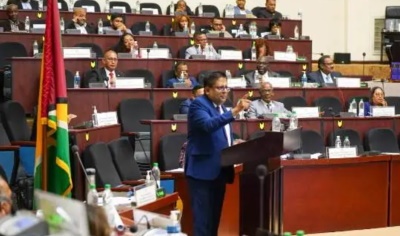GEORGETOWN, Guyana, CMC – The Guyana government Monday rolled out its GUY$1.146 trillion (One GUY dollar=US$0.004 cents) national budget for the next 12 months, allocating billions of dollars for the further development of several sectors, including energy, agriculture, health, and infrastructural development.
Finance Minister Dr. Ashni Singh, delivering his fifth fiscal package, which is a 46 percent increase over the last budget, told legislators that the fiscal package is being presented under the theme “Staying the course: Building prosperity for all” and that the Irfaan Ali administration intends to build upon the socio-economic developments since the administration came to power in the 2020 controversial regional and general election.
“Every Guyanese family should have access to decent housing… sufficient nutritious food… good quality healthcare… relevant educational and skills training opportunities… potable water and sanitation, and recreational facilities to support healthy living.
“These necessities matter not only for current comfort but, more importantly, for long-term economic empowerment,” Singh added.
He said that Guyana’s real Gross Domestic Product (GDP) growth last year was 33 percent, primarily attributed to a continued expansion of the oil and gas sector. In addition, the country’s Natural Resource Fund (NRF) saved an estimated GUY$1.9 billion last year.
“As with recent years, the estimated growth is driven largely by the expansion in oil and gas and, of course, the support services industry, which, when combined with growth observed in the other mining industry, outweighs the decline that was observed in gold and bauxite mining,” Singh said.
Singh, who did not outline any new taxes, said that Guyana received over US$1.3 billion in revenues from oil production in the Stabroek Block.
“The profit oil receipts recorded in 2023 correspond to two lifts in the last quarter of 2022 and 15 lifts in 2023. Two receipts related to 2023 are anticipated to be made this month. Those relate to lifts that occurred later in the year, that is to say, December of 2023,” Singh said, noting that royalty payments from the US-based oil and gas company ExxonMobil, the operator in the Stabroek Block, amounted to US$208.1 million last year.
He said that just over one billion US dollars was withdrawn from the NRF to finance national development priorities.
“In 2023, US$1.617 billion in petroleum revenue was deposited into the Fund, and at the end of the year, the overall balance, including interest income, stood at US$1.973 billion,” Singh told legislators.
The government has allocated GUY$95.7 billion to the energy sector this year, with Singh saying the funds will help the government meet short-term energy needs, invest in doubling its generating capacity for the medium term, and advance the transition towards cleaner and more renewable energy.
It also seeks to help rebuild the transmission and distribution (T&D) network to offtake the projected increases in generating capacity, invest in mini-grid systems for remote communities, and deploy household-level solutions for the less densely populated communities in the hinterland.
A total of GUY$80 billion is budgeted separately to advance the flagship 300 MW gas-to-energy project, with Singh noting that while no monies have been allocated for the 165 MW Amaila Falls Hydropower Project (AFHP), four firms have submitted pre-qualification documentation and these are currently being evaluated.
Singh said that there were other projects in the energy sector being financed by the budget, adding, “Once these projects are all completed, we will be generating and delivering adequate electricity to meet our needs, and we will be able to reduce the cost of electricity to half of the current levels.”
The government has budgeted nearly GUY$97.6 billion for the agricultural sector, with significant spending on drainage and irrigation as the country seeks to deal with its flood management capabilities.
Singh said the state-owned sugar company, GuySuCO, has been allocated six billion dollars GUY$1.3 billion to the rice sub-sector, GUY$78 million to the coconut sub-sector, GUY$2.6 billion to advance the production of other crops, including high-value produce like broccoli, cauliflower, bell peppers and lettuce, and GUY$967.8 million, to develop further the Tacama facility where corn and soya is being produced.
The government continues to support the agro-processing industry, allocating GUY$ 527.4 million and GUY$ 1.5 billion for the poultry sector and establishing a “modular duck processing facility.”
It is providing GUY$ 1.2 billion towards aquaculture and fisheries.
Singh said that GUY$204.1 billion has been allocated to upgrade and expand the country’s roads and bridges network. He said an additional GUY$73.2 billion is budgeted to continue the government’s program of constructing, rehabilitating, and maintaining community roads.
The government has projected spending in the health sector to be at GUY$129.8 billion, with Singh telling legislators that the government is investing heavily to engender a “resilient health sector,” adding that “like many developing countries around the world, Guyana continues to be challenged by competition for healthcare workers, especially nurses.”
The government’s housing program will benefit from GUY $78 billion, an increase from the $52.7 billion spent for constructing roads, drains, and bridges in the respective housing areas in 2023.
“We are continuing to build affordable homes to support all income categories,” Singh said, noting that since 2020, an estimated 1,165 homes have been completed, and works are ongoing for the construction of 1,134 additional homes.
This year, The education sector will receive GUY$135.2 billion, including GUY$4.1 billion, to support the University of Guyana (UG) operations.
A total of GUY$4.6 billion has been allocated to sports, with Singh saying, “Like in so many other sectors, our sports infrastructure is undergoing its most significant transformation in the history of our country.
“More is being invested in ensuring that our citizens, particularly our young people, have access to world-class sporting facilities.”
























































 and then
and then